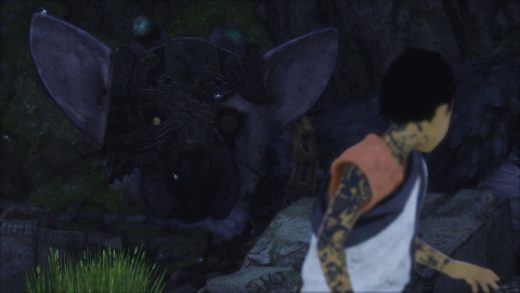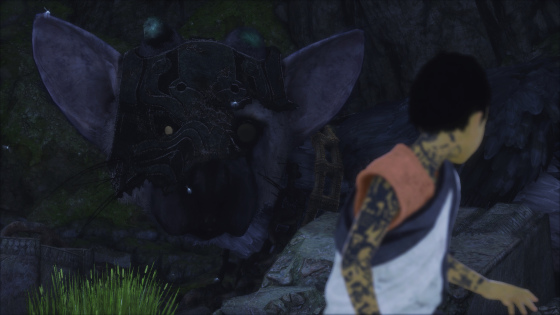‘The Last Guardian’ Explores the Power of Bonds Forged Without Words
‘The Last Guardian’ Explores the Power of Bonds Forged Without Words
A mythic feathered beast. A gangling but intrepid boy. The otherworldly glow of a ruins into which light falls like an elegiac curtain across a chapel to the enigmatic. A game we’ve been waiting to play for nearly a decade, from one of the medium’s esteemed creators.
The Last Guardian exists—is in fact playable at this year’s E3 game show—and you’ll be able to experience it yourself when it ships for PlayStation 4 on October 25.
It’s simpler visual framework may seem to betray its lengthy, harried developmental journey. The game was originally to be a 2011 PlayStation 3 release, but missed its marks, and was for a while thought to be in danger of vanishing entirely. If you scrutinize the demo or the game’s new trailer ungenerously, you might see it as a merely souped-up last-gen game.
Don’t let that get in the way of what’s important and perhaps even intentional here. The spare, almost cartoon-like features of the boy’s face become a wellspring of Scott McCloud-ian austerity into which players can pour themselves (or as McCloud puts it, amplify by simplifying). The unostentatious, at times gloomy color palette simply telegraphs that you’re in the spiritual realm of director Fumito Ueda’s last two games, 2001’s Ico and 2005’s Shadow of the Colossus.
And as you play The Last Guardian, that becomes clearer—that it’s less about visual razzle-dazzle than the interplay between incongruous or seemingly disconnected things: The boy and a gigantic griffin-like beast. The player and the world. The array of behavioral possibilities as you learn to communicate with your mythic companion. All of that connecting allusively to the logic of the world’s spatial conundrums.

Yes, the game is on one level about puzzling your way past obstacles or barriers, progressing from one area to the next, as in Ico. “There are places that may be too small to bring the beast, or walk alongside it,” says Ueda of the gameplay. “It’s such a wide and open space, but there are barriers where you’ll need to work with the beast to break down or somehow get over these hurdles.”
But to do that, you have to first figure out how to communicate with the creature. Not with words, but through actions or sometimes simple gestures as you work to figure out how to entice the creature to cooperate and help you both bypass obstacles. Establishing and growing relationship at first involves conveying to the creature that you’re worthy of trust.
In the demo, which chronicles the boy’s initial encounter with Trico (that’s the beast’s name), you can pick up barrels filled with who-knows-what to get its attention. “It’s basically his snack, it’s something Trico wants, like giving dog snacks to your dog,” says Ueda. And you’ll quickly notice that Trico’s eye color changes when barrels are near, one of the many nonlinguistic cues. “That signals the player, the boy, ‘Okay, now I’ve learned that by bringing him these barrels, he went for it, and now that he’s happy, maybe there’s a different expression that I get to see,’” explains Ueda. “These are things you’ll learn along the way, and then be able to have that closer communication and bond with the beast.”
There’s a kind of compound heuristic interest to that playing curve, too. “The player will start to slowly understand, as a game you will start to visually see these cues, or whether it’s just the behavior of the beast, or the boy, you’ll start to see this sort of communication form in maybe a faster way than the early stages of the game,” says Ueda.

The temptation may be to see Trico as a pet, which in most games involves a one-dimensional sidekick that’s merely an extension of your power in the world. “Trico is an independent animal,” says Ueda. “So it’s not like in other games where you have an animal or pet character, and they only do orders or commands, where they’re basically one of your tools, like a weapon.” Trico was designed to act and behave and move on his own, says Ueda, calling that interplay between your actuation and Trico’s reactions “a very fine balance between being able to give the player control, in a sense, of Trico, and things that you can’t control.”
It’s also, as in Ueda’s earlier works, about conveying more than mere gameplay ideas. The puzzles in The Last Guardian are, but they’re also ways of referencing the broader themes Ueda’s interested in. “What I would like people to feel is that there’s beauty in sadness,” explains Ueda. “It’s not that I’m always conscious, like always thinking that this has to be the theme of the game. But there’s something I want to leave an impact or impression of, to perhaps move anyone who comes in contact with my games. It just ends up being that that’s something that works well with the ideas and the direction that I like to take things.”
What to make of the boy and beast? Is Trico the eponymous custodian? Of something literal or ephemeral? Or is the last guardian the boy himself? “There have been changes in my personal life, but my recent adult life seems weird, having a career in the industry,” says Ueda when asked what inspired the character you play as. “I actually go back in time to when I was a young boy, when I was a child, and so it’s really tracing back childhood memories, and trying to recall what I was feeling at that time, or what I did, or how was I introduced to these themes or thoughts and feelings.”
(20)



